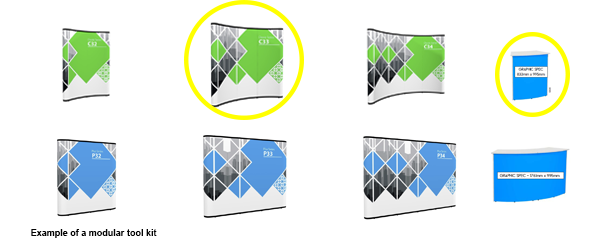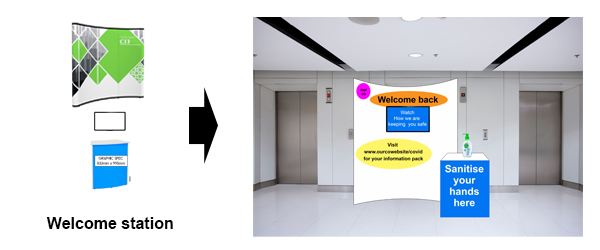Using modular bespoke display stands to create a covid safe working environment
Contents |
[edit] Getting people back to business
As businesses attempt to open up again after the coronavirus lockdown they are facing at least two key challenges:
- Providing a Covid-19 safe environment for people to operate in be that work, leisure, retail, health, education
- Persuading people that the environment is safe for them to visit
Providing a safe environment for people to operate in is likely to be an evolutionary process depending on how the Covid-19 pandemic develops and the subsequent guidelines issued by the Government to industry. At the time of writing this article the government guidance for a Covid-19 safe operating environment centres around two key areas:
- Increased hygiene - Higher frequency of hand washing and cleaning surfaces
- Minimising social interaction - Social distancing (2 metres at time of writing), facility layouts, shift patterns, traffic flow
Persuading people to go back into 'working' environments is as much about perception as it is reality. People need to be:
- Re-assured they will be safe
- Informed of how they need to act to stay and keep others safe
- Guided around the facility in a way that will keep them safe
The delivery of a Covid-19 safe environment for workers, customers or visitors to a facility will, in part, require temporary structures to re-assure, inform and guide people. Each building may have differing requirements and it is likely the structures and messages will change over time, as the Covid-19 pandemic evolves and Government guidelines change.
[edit] Using modular bespoke displays
Pop-up modular stands can provide a solution that helps promote safe behaviour of visitors to a facility and can be easily set-up, re-messaged and re-configured as the situation requires.
Modular displays are created by selecting a suitable combination of modular frames to fit a required space and structure. Bespoke graphics and accessories are then added to convey a message and illicit a desired reaction from the intended audience.
Example: The two pop-up frames and plinth on the left below can be used to create the three displays below on the right.
[edit] Stages of development
[edit] Briefing
A brief is developed between a client and a display provider, such as W7 Marketing Communications. The purpose of the brief is to make sure the display provider understands:
- What the purpose of the stand is
- What the physical/spatial requirements are
- What mandatory branding/messaging is required
An example of a brief might be:
- Purpose - To provide a sanitising station and display that will encourage people entering the building to sanitise their hands and inform them that they should observe social distancing and good hand hygiene whilst on site
- Spatial requirements - To be positioned inside the doors of the main foyer which is 10m wide by 8m deep with a 3m height restriction. Not obstructing the doors or the lifts
- Branding 'The Office Block' should appear within a design which reflects NHS type colours to help recognition and credibility of a medical type of message
[edit] Layout plan
At this stage the display provider would look at the space constraints and the suite of modular structures they have in their toolkit. Then pick a combination that they think will provide a suitable structure to deliver the purpose of the brief within the spatial requirements of the brief.
Example of the type of modular options and a possible selection for example brief above.
A scaled plan drawing will then be produced to check the structure will fit appropriately in the required space.
This is how it would look for the foyer example.
[edit] Concept design
The concept design is produced by the stand supplier and is a rough visual representation of the proposed structure and graphics of the stand. The purpose is for the stakeholders to discuss and agree before final specification, artwork and production.
In the foyer example, a concept design could look something like this:
[edit] Artwork and production
Once the final concept design is agreed, it can be used as a visual brief to a graphic designer to produce the artwork that will be required by the stand supplier to produce the graphic panels. The stand supplier will supply a template for the graphic designer to make sure the final artwork fits the print space correctly.
[edit] Delivery and set up
Modular pop-up stands come in hard cases that can be easily transported and man-handled. The stands themselves are easily set up by anyone, so having additional visitors to a site for set-up is optional.
[edit] Covid-19 display ideas
Ideas for how modular bespoke pop-up display stands could be used to help create a safe 'working' environment
[edit] Welcome station
When people return to a working environment, they will need to be re-assured that the host is doing everything they can to keep everyone safe. A welcome station near the entrance can provide physical re-assurance with a hand sanitising station and convey messages via a video screen and graphics on what else the host is doing and, what is expected of the visitor. A web address highlighted on the display could take the visitor to an information site they could access on their phone or laptop.
[edit] Instructions/Sanitising station
Visitors to a working facility operating under Covid-19 safe guidelines will need to be reminded of the procedures they need to follow to stay safe. Displays placed around the building re-enforcing these messages can help keep safe procedures top of mind and encourage best practice behaviour.
The displays and messages can be easily moved around to avoid fatigue.
[edit] Controlling traffic flow
Controlling people traffic flows around a building will be a key part of helping maintain social distancing during the Covid-19 pandemic. Modular display stands can be used graphically and physically to inform and control traffic flows.
[edit] Temporary rest areas
Pop-up modular displays can be configured to create a number of temporary environments that help provide a Covid-19 safe environment to site visitors. The structures can be used to give individuals a safe place to rest and eat their food, and the graphics can be designed to provide a pleasant environment.
[edit] How to get started
- Articulate your requirements in some form of written brief
- Talk through the brief with a pop-up modular stand supplier like W7 Marketing Communications
For further information visit W7 Marketing Communications or contact Simon Baxter
[edit] Resources
- GOV.UK - Working safely during coronavirus
- HSE - Working safely during the coronavirus (COVID-19) outbreak
--Simon Baxter 09:50, 17 Jun 2020 (BST)
Featured articles and news
Independent Building Control review panel
Five members of the newly established, Grenfell Tower Inquiry recommended, panel appointed.
ECA progress on Welsh Recharging Electrical Skills Charter
Working hard to make progress on the ‘asks’ of the Recharging Electrical Skills Charter at the Senedd in Wales.
A brief history from 1890s to 2020s.
CIOB and CORBON combine forces
To elevate professional standards in Nigeria’s construction industry.
Amendment to the GB Energy Bill welcomed by ECA
Move prevents nationally-owned energy company from investing in solar panels produced by modern slavery.
Gregor Harvie argues that AI is state-sanctioned theft of IP.
Heat pumps, vehicle chargers and heating appliances must be sold with smart functionality.
Experimental AI housing target help for councils
Experimental AI could help councils meet housing targets by digitising records.
New-style degrees set for reformed ARB accreditation
Following the ARB Tomorrow's Architects competency outcomes for Architects.
BSRIA Occupant Wellbeing survey BOW
Occupant satisfaction and wellbeing tool inc. physical environment, indoor facilities, functionality and accessibility.
Preserving, waterproofing and decorating buildings.
Many resources for visitors aswell as new features for members.
Using technology to empower communities
The Community data platform; capturing the DNA of a place and fostering participation, for better design.
Heat pump and wind turbine sound calculations for PDRs
MCS publish updated sound calculation standards for permitted development installations.
Homes England creates largest housing-led site in the North
Successful, 34 hectare land acquisition with the residential allocation now completed.
Scottish apprenticeship training proposals
General support although better accountability and transparency is sought.
The history of building regulations
A story of belated action in response to crisis.
Moisture, fire safety and emerging trends in living walls
How wet is your wall?
Current policy explained and newly published consultation by the UK and Welsh Governments.
British architecture 1919–39. Book review.
Conservation of listed prefabs in Moseley.
Energy industry calls for urgent reform.






































